|
The Decisive General Elections (No.54)
02 June 2014
Yesterday marked twenty years since the first TGV Eurostar train traversed the Channel Tunnel connecting England and France. The 50.5 km long undersea tunnel, connecting Calais station in France and Folkestone in Great Britain, is said to be one of the seven engineering marvels of the modern age. It took more than 260 years since the idea’s inception by French engineer Nicolas Desmarets in 1751 to construct an undersea tunnel between England and France. Construction of the tunnel, also sometimes called the Dover Tunnel, was completed in just less than seven years, since construction had started on the British side in 1987. Compared to the world’s longest underground tunnel, Japan’s Seikan Tunnel (53.85 km), which took 27 years before completion in 1988, the speed at which the Channel Tunnel was built is quite remarkable. However, the construction costs were six times as high as originally estimated and the number of travellers was only a third of what was envisioned. As a result, the operation and management of the Channel Tunnel became a huge loss-making operation, and in 2006 went bankrupt. The reorganisation procedures were taken to the court of commerce in France, and currently, Group Eurostar is commissioned by both governments of France and the UK to operate and manage the tunnel until the end of this century. Eurostar is also available from Brussels, and you can travel to London in two hours. Of course, there is also the possibility to cross the channel by car. Last year about 10,000 cars and trucks per day took the undersea tunnel. It should be noted that the Gotthard Base Tunnel in Switzerland (57.091 km), to be completed in 2018, is expected to be the world's longest tunnel for public transport. To drive through such a long tunnel seems rather frightening for me, though.
< Historical General Elections >
As determining the future of Belgium, important ‘historical general elections’ (local Belgian newspaper) took place last Sunday, alongside the three regional elections and elections to choose the Belgian representatives for the European Parliament. The voting results of the elections were supposed to be known the following day, but due to technical issues in certain places to gather the computer votes, it took up to two days for the final results to be announced. 150 members of the federal parliament were selected by a proportional representation system, but why would these elections be so ‘historical’? Depending on the votes gathered by the rapidly-growing political party of the New Flemish Alliance (N-VA), who are advocating the splitting-off of the north of Belgium (Dutch-speaking region), Belgium would be divided north and south, and the possibility would increase that the country would move from its current federal system to a ‘confederation’. If that were to happen, it would mean that there would be two countries effectively, and ‘Belgium’ would just be the country’s name in appearance. Belgians were asked during these elections which form of government they would choose, regarding such an outcome. The result of the elections was that the N-VA had won in Flanders in the north, although they did not budge from their place as the leading party in the federal parliament. In Wallonia in the south (French-speaking region) the socialist party had come out on top, just as previously. This outcome has left lots of possibilities to form coalitions. At least it does not look like the situation is progressing towards a ‘confederation’ instantly. After all it is Belgium where in the general elections of 2010 it took 541 days to form a new coalition, so it is to be seen what will happen this time around.
< Relocation Ceremony of Mitsui Soko Express Europe >
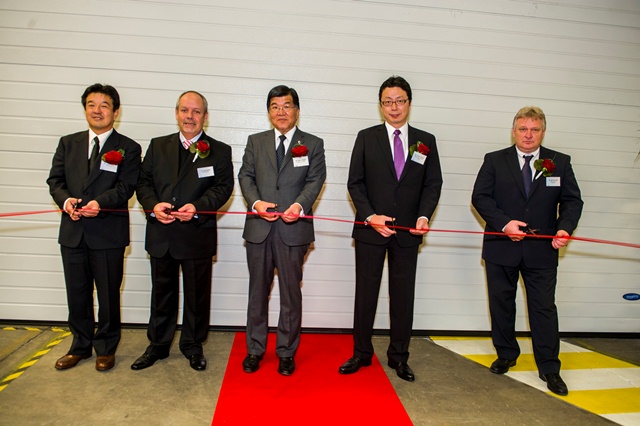 About ten days ago, the ceremony for the relocation of the office building of Mitsui Soko Express Europe (MSE) was held nearby Zaventem Airport at their new offices. I attended as one of the guests. MSE is a logistics company in the Toyota group, which was established about two years ago out of the merging of two Japanese companies that were already operating in Belgium. Their focus lies on air cargo transport, but they also transport over sea and land, and carry out customs clearance services, developing a so-called ‘intermodal transportation’ global network. MSE Europe possesses offices in the UK, the Czech Republic, as well as in Turkey, and has around 50 employees (30 in Brussels), of whom seven are Japanese (five of whom in Brussels). With the relocation to the new office buildings and warehouse of 1800 m2, it is a total change and has greatly facilitated the day-to-day business. Senior managing director Takeshi Gohara of the Japanese parent company attended the ceremony and showed eagerness for the active development to come. In my congratulatory address I pointed out the importance of logistics for the economy. I mentioned that improvement could be seen in Japan and Europe’s economies and that amidst the on-going EPA (FTA) negotiations between Japan and the EU, MSE Europe are expected to further expand. The world of logistics is fierce and many Japanese companies are operating in Belgium, therefore I would like them to compete on friendly terms to really support the logistics. About ten days ago, the ceremony for the relocation of the office building of Mitsui Soko Express Europe (MSE) was held nearby Zaventem Airport at their new offices. I attended as one of the guests. MSE is a logistics company in the Toyota group, which was established about two years ago out of the merging of two Japanese companies that were already operating in Belgium. Their focus lies on air cargo transport, but they also transport over sea and land, and carry out customs clearance services, developing a so-called ‘intermodal transportation’ global network. MSE Europe possesses offices in the UK, the Czech Republic, as well as in Turkey, and has around 50 employees (30 in Brussels), of whom seven are Japanese (five of whom in Brussels). With the relocation to the new office buildings and warehouse of 1800 m2, it is a total change and has greatly facilitated the day-to-day business. Senior managing director Takeshi Gohara of the Japanese parent company attended the ceremony and showed eagerness for the active development to come. In my congratulatory address I pointed out the importance of logistics for the economy. I mentioned that improvement could be seen in Japan and Europe’s economies and that amidst the on-going EPA (FTA) negotiations between Japan and the EU, MSE Europe are expected to further expand. The world of logistics is fierce and many Japanese companies are operating in Belgium, therefore I would like them to compete on friendly terms to really support the logistics.
< Presentation of the BJA Rapport at the Ambassador’s Residence >
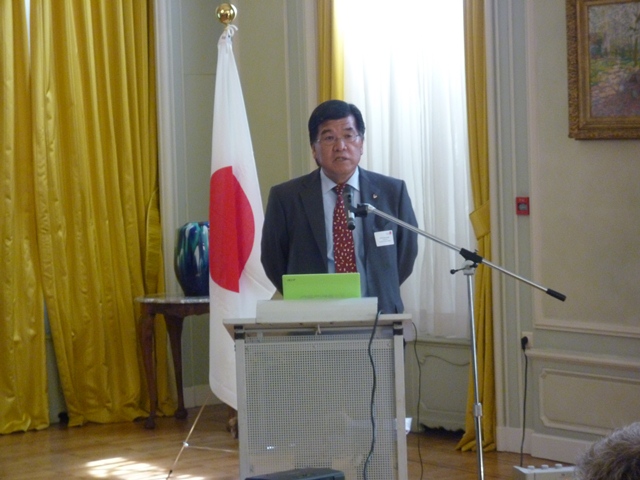 The other day, a presentation of the survey rapport ‘Belgium and its Neighbours: Business Climates Compared’ gathered by the investment committee of the Belgium-Japan Association and Chamber of Commerce (BJA) was held at the residence of the Ambassador. About 50 members of the BJA, along with the president, G. Declerck were there. Besides an explanation by chairman of the investment committee, Masatomo Nomura, there was also a testimonial by F. Hoorelbeke, president of Daikin Europe, which has already gained ground in Belgium, on his experience. According to chairman Nomura, Belgium has not always got a good image internationally when it comes to its business environment, but in reality seems to have a good investment climate: Globally Belgium ranks number one in overall productivity (GDP per person employed) and on the globalisation index. Furthermore, when looking in terms of logistics, it has the highest road and rail network density and it is the cheapest to rent prime locations for distribution, and in the over-all ranking of port facilities, the port of Antwerp ranks number one in Europe. In addition to this, the language skills of the Belgians and the quality of the management schools, which have received international acclaim, also add to this good investment climate. In the testimonial by president Hoorelbeke of Daikin Europe, he explained that the advantage of Belgium’s location being in the centre of Europe and its excellent infrastructure, its EU and NATO headquarters in Brussels, increases the appeal to invest in Belgium. What was surprising in the BJA report this time, was that though the high corporation tax rate in Belgium is often pointed out as a negative factor, in reality, the effective tax rate is low at about 26.3%, because several preferential measures are taken This is lower than the Netherlands and Germany and around the same level as Italy and the UK. For foreign companies that are looking into the possibility of investing in Belgium, I think this is a valuable fact that cannot be obtained from cross country comparisons of nominal tax rates. The other day, a presentation of the survey rapport ‘Belgium and its Neighbours: Business Climates Compared’ gathered by the investment committee of the Belgium-Japan Association and Chamber of Commerce (BJA) was held at the residence of the Ambassador. About 50 members of the BJA, along with the president, G. Declerck were there. Besides an explanation by chairman of the investment committee, Masatomo Nomura, there was also a testimonial by F. Hoorelbeke, president of Daikin Europe, which has already gained ground in Belgium, on his experience. According to chairman Nomura, Belgium has not always got a good image internationally when it comes to its business environment, but in reality seems to have a good investment climate: Globally Belgium ranks number one in overall productivity (GDP per person employed) and on the globalisation index. Furthermore, when looking in terms of logistics, it has the highest road and rail network density and it is the cheapest to rent prime locations for distribution, and in the over-all ranking of port facilities, the port of Antwerp ranks number one in Europe. In addition to this, the language skills of the Belgians and the quality of the management schools, which have received international acclaim, also add to this good investment climate. In the testimonial by president Hoorelbeke of Daikin Europe, he explained that the advantage of Belgium’s location being in the centre of Europe and its excellent infrastructure, its EU and NATO headquarters in Brussels, increases the appeal to invest in Belgium. What was surprising in the BJA report this time, was that though the high corporation tax rate in Belgium is often pointed out as a negative factor, in reality, the effective tax rate is low at about 26.3%, because several preferential measures are taken This is lower than the Netherlands and Germany and around the same level as Italy and the UK. For foreign companies that are looking into the possibility of investing in Belgium, I think this is a valuable fact that cannot be obtained from cross country comparisons of nominal tax rates.
< The Japanese Chemist Who Received from a Belgian University >
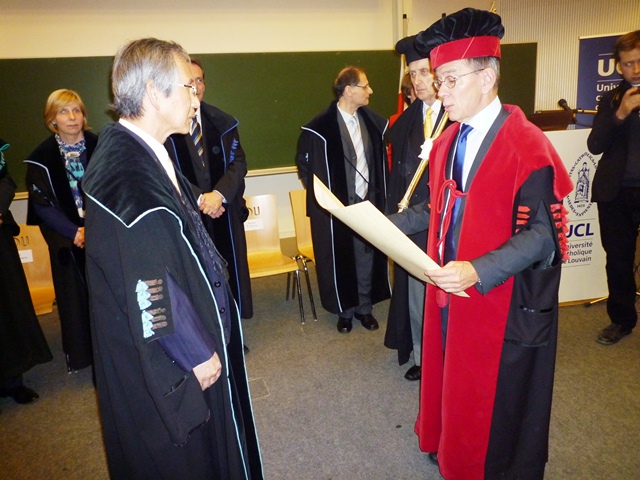 Last week at the Catholic University of Louvain, the title of doctor emeritus was given to Masatake Haruta of the Tokyo Metropolitan University and other researchers. At the ceremony, held by the Nano science institute of the faculty of sciences at the university, it was explained that the high acclaim towards the research by professor Haruta on the catalysis by gold nanoparticles was the reason for awarding the title. Up until recent time it was generally believed amongst chemists that gold was inert and unsuitable as a catalyst, but professor Haruta discovered, during his study as a visiting researcher at UCL from1981 to 1982, that gold nanoparticles form an excellent catalysis. An elder professor, who had assisted Haruta during his study at UCL over thirty years back, also attended the ceremony. I was filled with warmth hearing professor Haruta say to the person in front, who has well advanced into his eighties, that “because of your guidance, I am the researcher who I am today.” I was pleased to know that after his study at UCL, professor Haruta continued his exchange through collaborative research, and academic exchanges between Japan and Belgium were carried out in such an unexpected field of study. Professor Haruta is a renowned researcher who is regarded a candidate for the Nobel Prize for Chemistry. It is surprising that such a person holds profound ties with Belgium. Last week at the Catholic University of Louvain, the title of doctor emeritus was given to Masatake Haruta of the Tokyo Metropolitan University and other researchers. At the ceremony, held by the Nano science institute of the faculty of sciences at the university, it was explained that the high acclaim towards the research by professor Haruta on the catalysis by gold nanoparticles was the reason for awarding the title. Up until recent time it was generally believed amongst chemists that gold was inert and unsuitable as a catalyst, but professor Haruta discovered, during his study as a visiting researcher at UCL from1981 to 1982, that gold nanoparticles form an excellent catalysis. An elder professor, who had assisted Haruta during his study at UCL over thirty years back, also attended the ceremony. I was filled with warmth hearing professor Haruta say to the person in front, who has well advanced into his eighties, that “because of your guidance, I am the researcher who I am today.” I was pleased to know that after his study at UCL, professor Haruta continued his exchange through collaborative research, and academic exchanges between Japan and Belgium were carried out in such an unexpected field of study. Professor Haruta is a renowned researcher who is regarded a candidate for the Nobel Prize for Chemistry. It is surprising that such a person holds profound ties with Belgium.
< Wedding Banquet of the Janssen Family >
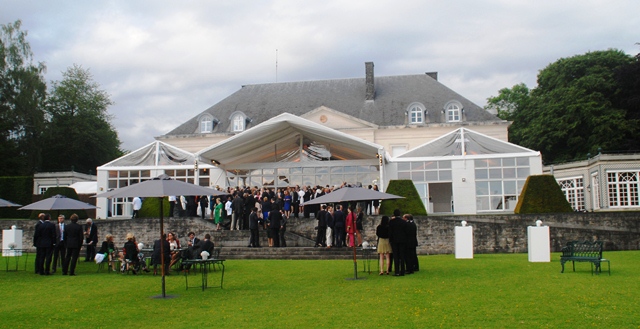 Two weeks ago, in the weekend, a wedding reception of the Janssen family, Belgium’s second or third wealthiest family, was held at their residence in the outskirts of Brussels. I received an invitation to attend the wedding reception from the groom with whom I had got acquainted. The wedding reception was not, as perhaps you might think, held in a hotel as would be in Japan, but it was rather a fun occasion, like a sort of garden party. The civil marriage was held on that day during the daytime at the city hall in Bruges. The religious marriage will be, in accordance with Belgian practise, held on another day. I was surprised by the scale of the wedding reception venue of Garenne, the residence of the Janssen family. From the front gate to the entrance of the mansion it is a slow 10 minute-drive through a forest. The site area is estimated to be at least a 100 ha. Two weeks ago, in the weekend, a wedding reception of the Janssen family, Belgium’s second or third wealthiest family, was held at their residence in the outskirts of Brussels. I received an invitation to attend the wedding reception from the groom with whom I had got acquainted. The wedding reception was not, as perhaps you might think, held in a hotel as would be in Japan, but it was rather a fun occasion, like a sort of garden party. The civil marriage was held on that day during the daytime at the city hall in Bruges. The religious marriage will be, in accordance with Belgian practise, held on another day. I was surprised by the scale of the wedding reception venue of Garenne, the residence of the Janssen family. From the front gate to the entrance of the mansion it is a slow 10 minute-drive through a forest. The site area is estimated to be at least a 100 ha.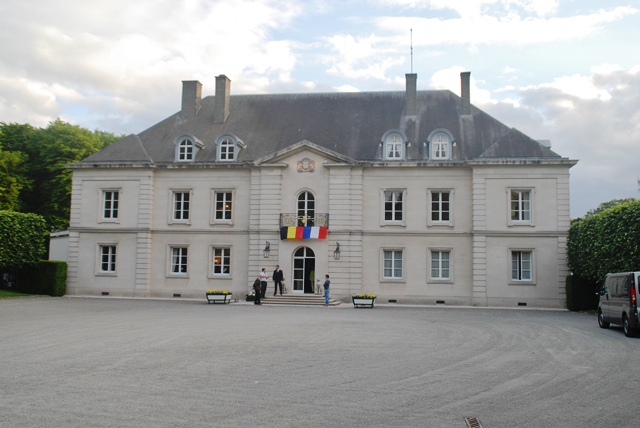 Over half of the guests were relatives of the Janssen family or were important figures from Belgium’s economic world. Being the sole Asian person there, I felt a bit out of place. Also, what fascinated me when I received the invitation was that the bride and groom’s gift list was uploaded to a specially set up webpage where the invited guests could choose from over a 100 items which gift they wanted to give. When you click on one of the items on the screen, that item disappears from the screen, so as not to have the same present given to the bride and broom several times. The person who gives a gift knows beforehand what the bride and groom would like, and moreover the price is displayed along, so if you send money you can avoid the effort to go shopping. This way of doing things seems to be becoming popular amongst young couples of Belgium’s upper class. How interesting. Over half of the guests were relatives of the Janssen family or were important figures from Belgium’s economic world. Being the sole Asian person there, I felt a bit out of place. Also, what fascinated me when I received the invitation was that the bride and groom’s gift list was uploaded to a specially set up webpage where the invited guests could choose from over a 100 items which gift they wanted to give. When you click on one of the items on the screen, that item disappears from the screen, so as not to have the same present given to the bride and broom several times. The person who gives a gift knows beforehand what the bride and groom would like, and moreover the price is displayed along, so if you send money you can avoid the effort to go shopping. This way of doing things seems to be becoming popular amongst young couples of Belgium’s upper class. How interesting.
|

